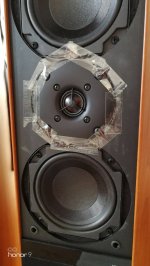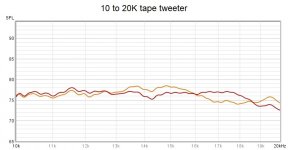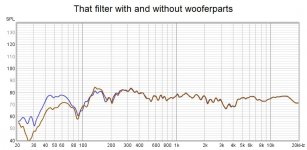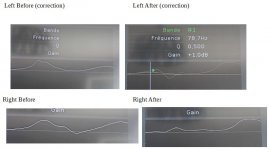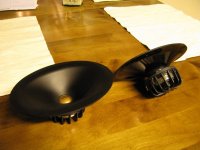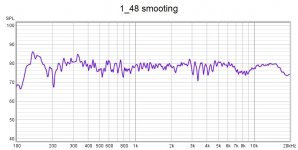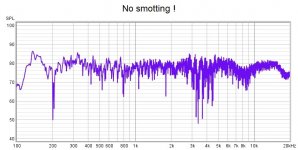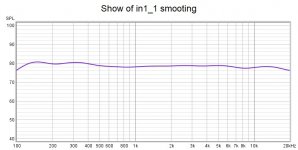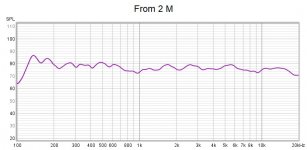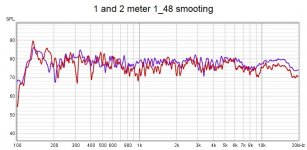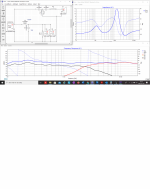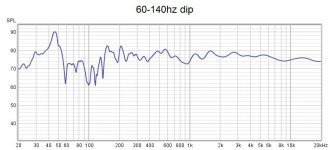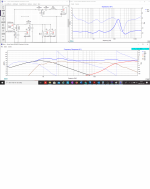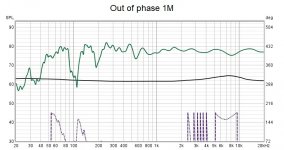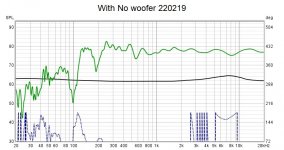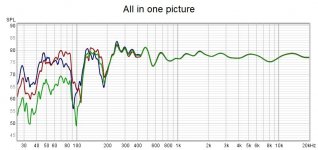So a higher sensibility tweeter than 90db maybe fits better? I am just an amateur..
Jawen maybe you could try the tweeter you tested at the beginning of the the project just for fun to see how it works now?
Jawen maybe you could try the tweeter you tested at the beginning of the the project just for fun to see how it works now?
Will come back answering you Ray, Moorclos and Belemakare later!
Just testing if i can get the tweeter to behave a little better in total, before i do some "bigger things", so i know more and learn.
This is the differance on the tweeter in box between 10 and 20K when mesauring, when only putting tape over the small 1-2mm gap around tweeter and baffle/cabinette.
And it show just how important the milling job is when you working on the baffle, and want the best results!
Green curve is taped and 2 lines in mesauring is 1dB 1/48 smooting
Just testing if i can get the tweeter to behave a little better in total, before i do some "bigger things", so i know more and learn.
This is the differance on the tweeter in box between 10 and 20K when mesauring, when only putting tape over the small 1-2mm gap around tweeter and baffle/cabinette.
And it show just how important the milling job is when you working on the baffle, and want the best results!
Green curve is taped and 2 lines in mesauring is 1dB 1/48 smooting
Attachments
In red/orange without woofer and woofer xoverpartshow does it measure without the bass connected?
Attachments
Jawen, interesting, and easy to make it good
Just testing if i can get the tweeter to behave a little better in total, before i do some "bigger things", so i know more and learn.
...
And it show just how important the milling job is when you working on the baffle, and want the best results!
waveguide for SB26
this give some idea for a Center Channel [with 2x 5FE120 + 1SB26 ADC and a waveguide - 2 front port - or a big enclosure]
https://www.diyaudio.com/community/threads/open-source-waveguides-for-cnc-3d-printing.318190/
https://techtalk.parts-express.com/...7600-3d-printed-waveguides/page36#post1398387
Had seen that Waveguide before, and I can not interpret the mesaurements....But do you think it look good ??
And my goal is to keep the original "outside" cabinette as original as possible.
Very aware that you are getting fed up with all this, can i suggest that you pick your favourite or the one that meets the design goals and work it a bit more.
Hahahaha....Yes Ray you are so right, sometime i want to throw a hand grenade on them.....especially when you spend time changing "difficult to access" component values, and the result of the mesaurement is 99,7% the same as before...And sometimes its not logically.
About the tweeter and tweeter mesaurements.As to the dip at 3500 once you have removed the 2 ohm there is only so much the SB26 can give, its a a great tweeter for the money but its max sensitivity is 90 dB
The tweeter sounds really great but have a dip in 3-5K range on "the new" xover....And i don`t know why?
Modified Jamo xover don`t have that 3-5K dip, but that xover is constructed in a different way.
Maby today i will try to modify the baffle a little, and see how it turns out.
It is from mesauring curve without xover on the tweeter in box, and me putting that curve in XSim....**** in-**** out.the dip at 3500
So in XSim with that FRD/SPL curve, it always going to show that dip at 3500 hz.
I will try that now when i understand a little better, and aim for 90-91dB at 1K slowly falling and integrate with tweeter.a bit of attenuation on the 5Fe120's
Hahahahaha....Your so right 🤣Most people strive for perfection, so knowing you have a dip in the frequency response at X Hz isnt going to naturally help you appreciate your speaker,
Yes, i will try one more thing here...Then i will go for one of them !Find the most enjoyable design ( hopefully you know which one it is) from your recent tests of the last two days then configure both speakers Xover's so that they match to your favourite design and listen to them over the next two weeks
Putting 4 new drivers into an existing box and not knowing the original loudspeaker parameters was always going to be tricky, A lot of people worry about just changing the tweeter. I think you deserve a badge for integrating two woofers and a tweeter. Sorry we didn't get the bass (basically sub woofer) going to your liking.
Thank you for your uplifting positive words Ray 🙂
Best regards John
Graph to compare with waveguideHad seen that Waveguide before, and I can not interpret the mesaurements....But do you think it look good ??
And my goal is to keep the original "outside" cabinette as original as possible.
French project With sB26 5'' waveguide and satori MW16P-04
- As I read, it looks good [......] but only 4" seems to fit, with low gain, so near worthless (and with risks rework the joinery without going back...)
- Perhaps, put some $ on better capactitor (like on tweeter) (like: Jantzen superior with a 0.01µF in //, ...)
_____________________________________________________________________
Today I use auto calibration of my amp, and it sounds better than before (more than slightly) --[with my ears]
Room Correction with original speakers, and with newer.
. bass/medium - less correction good || tweeter - more (need adjustment on cross-over)
Attachments
When i showd the differance when putting tape around little gap around tweeter, it was more to show how little things can change a driver`s experience.Jawen, interesting, and easy to make it good
Don`t know if you even can hear those differances because its so high up in frequency, but for sure makes a more "perfect" mesaurement-curve if you want to show of.
My hearing now at my age is 15.400 Hz, when i test it a few month back.
That Waveguide is not a good choice in this project, and maby not in other project either.
- As I read, it looks good [......] but only 4" seems to fit, with low gain, so near worthless (and with risks rework the joinery without going back...)
- Perhaps, put some $ on better capactitor (like on tweeter) (like: Jantzen superior with a 0.01µF in //, ...)
Its expensive at about 130 Euro for 2, it have also to rough surface from 3D printing/material...poorly designed screw holes.
And every tweeter dosen`t get better with waveguide as in this case i think.
In my first DIY speakerproject (the pic a posted before) i use a waveguide for a 94 dB Audax TW025A28 tweeter that i liked.
That Waveguide was perfectly designed after alot of testing sizes and shape by Dave Pellegrene
.
In this tread you can read about my waveguides being made.
https://techtalk.parts-express.com/.../59178-audax-tw025a28-testing-with-waveguides
I have never used eq to correct frequency, and I can not interpret your photos.Today I use auto calibration of my amp, and it sounds better than before (more than slightly) --[with my ears]
Room Correction with original speakers, and with newer.
. bass/medium - less correction good || tweeter - more (need adjustment on cross-over)
But if you hear its better... its better...
Because you are the boss in terms of how your speakers sound 🤟
Best regards John
Attachments
Wise reflections JAWEN, marked by a return of experience. The choice to abandon the waveguide was already made.
(I miss some subtleties in your considerations, English being a language "learned" at school for me)
The optimization of the cross-over, remains the main work (here) to test in situation. (in simulation, then with intermediate components, then the final components of honorable quality, once the values are validated).
For the room eq, what I see from the old and new measurements, is that the response of the Jamo speakers without modification, did not finally put forward the tweeter (original or modified), in retreat, which is seen in your measurements. (and the few measurements I made under xsim, which without modification of the crossover, pulls the tweeter down in terms of spl output). [the shortcomings I see on my charts with the cross over upgrade will make the room eq irrelevant]
The only positive point concerning me, at this stage, with 'very' little investigation, is to note, that there was a visible gain with more body on the bass and the medium, and those without thorough analysis, which accredits the characteristics of the woofers and mediums retained.
Note: this diy project is my first work, so I am learning by doing. And there is a lot to learn as I go along. Some siren fields try to seduce, but are only relevant once certain steps have been taken. 😉
(I miss some subtleties in your considerations, English being a language "learned" at school for me)
The optimization of the cross-over, remains the main work (here) to test in situation. (in simulation, then with intermediate components, then the final components of honorable quality, once the values are validated).
For the room eq, what I see from the old and new measurements, is that the response of the Jamo speakers without modification, did not finally put forward the tweeter (original or modified), in retreat, which is seen in your measurements. (and the few measurements I made under xsim, which without modification of the crossover, pulls the tweeter down in terms of spl output). [the shortcomings I see on my charts with the cross over upgrade will make the room eq irrelevant]
The only positive point concerning me, at this stage, with 'very' little investigation, is to note, that there was a visible gain with more body on the bass and the medium, and those without thorough analysis, which accredits the characteristics of the woofers and mediums retained.
Note: this diy project is my first work, so I am learning by doing. And there is a lot to learn as I go along. Some siren fields try to seduce, but are only relevant once certain steps have been taken. 😉
Last edited:
English being a language "learned" at school for me)
The same for me Moorclos, my native language is Swedish, and its not always easy to "completly understand everything" written/spoken because HiFi has a lot of "special words"...Not learn those words in school 😉
Did some progres on the "new xover" with small values, now down at -+2,5dB from about 220-20.000hz
Note that there is no woofer involved, so no woofer filter either!
Dont now exactly how i will "tackle" respons down there at 170-220hz , but have tried with different fillings and thats no differance!
Here is curves with no smooting at all and with 1/48 smooting which is hardly nothing, and maby Ray can see out more than we of it 😉
And just to show how the same curve looks like with 1/1 smooting.
Best regards John
Attachments
Last edited:
The dip in 160-220 hz dosent seems to be there when i mesaure from 2 meter, even if 1K and over 10K was lowered slightly.
Normal and 1/48 smooting from 1 and 2 meters.
And XSim values/filter....xover-point a little low at 2.300 hz and would like to get impedance up just a little around 3,5K......Ray 😉 hahaha
/John
Normal and 1/48 smooting from 1 and 2 meters.
And XSim values/filter....xover-point a little low at 2.300 hz and would like to get impedance up just a little around 3,5K......Ray 😉 hahaha
/John
Attachments
Last edited:
Looks good to me.
The extra noise at the crossover in post 209 with no smoothing is showing us that the phase match isn't great in that frequency area and explains why when modelled in Xsim you or I struggled to get a smoother response. I need to read up on omni mic and its phase response, just to understand it better.
Right now If you had the two mid woofers and tweeter in a smallish 350mm - 400mm tall box with say 10 -12 litres volume and these were near a corner, maybe you would have something you could live with for years.
Yes, if you make some new boxes you will obtain slightly different measurement's and you would have to make some tweaks again due to new baffle size and diffraction.
Oh and definitely tightly rebate the tweeter, and with what you have learned it will be a fine small speaker with only low bass being a concern. Again placing it hard against a wall or near to a corner could be enough with room gain for many people. Remember people have used stacked and inverted LS3/5A's to demonstrate some pretty expensive gear and they would have a had a few more nulls than what you are measuring. Due to the two tweeters of the stacked array interacting.
You would have to calculate how much the resistor across the coil would need at 60 Watts or so input to stop that baking itself or the PCB, but that's easy enough to calculate and cheaper than some exotic capacitors.
The extra noise at the crossover in post 209 with no smoothing is showing us that the phase match isn't great in that frequency area and explains why when modelled in Xsim you or I struggled to get a smoother response. I need to read up on omni mic and its phase response, just to understand it better.
Right now If you had the two mid woofers and tweeter in a smallish 350mm - 400mm tall box with say 10 -12 litres volume and these were near a corner, maybe you would have something you could live with for years.
Yes, if you make some new boxes you will obtain slightly different measurement's and you would have to make some tweaks again due to new baffle size and diffraction.
Oh and definitely tightly rebate the tweeter, and with what you have learned it will be a fine small speaker with only low bass being a concern. Again placing it hard against a wall or near to a corner could be enough with room gain for many people. Remember people have used stacked and inverted LS3/5A's to demonstrate some pretty expensive gear and they would have a had a few more nulls than what you are measuring. Due to the two tweeters of the stacked array interacting.
You would have to calculate how much the resistor across the coil would need at 60 Watts or so input to stop that baking itself or the PCB, but that's easy enough to calculate and cheaper than some exotic capacitors.
You would have to calculate how much the resistor across the coil would need at 60 Watts or so input to stop that baking itself or the PCB, but that's easy enough to calculate and cheaper than some exotic capacitors.
Yes, the 5,6 ohm resistor need to be a 30 watt at 200 hz in 60W amp-power and 40 watt if 100W amp-power used
See that in measuring, but don`t know what it is more then "not perfect" hahahaThe extra noise at the crossover in post 209 with no smoothing is showing us that the phase match isn't great in that frequency area and explains why when modelled in Xsim you or I struggled to get a smoother response. I need to read up on omni mic and its phase response, just to understand it better.
That could be okey for most people (but not me) hahaha....I don´t build DIY from JBL drivers, because of the lack of 20-35 hz possibility.Right now If you had the two mid woofers and tweeter in a smallish 350mm - 400mm tall box with say 10 -12 litres volume and these were near a corner, maybe you would have something you could live with for years.
I have 2 like new in a box 15 inch JBL 2215h that i bought year 2000, that sound great when i tested them even up to 900 hz lying on the floor without cabinette !
Should i damper the tweeter output you think Ray?definitely tightly rebate the tweeter
So greateful for you´r coments 🙂
Now im trying to put in the woofer and woofers xover parts in...Hope it will function okey
Best regards John
What i am thinking about right now is the mids recomended by jawen a tweeter about 92db,tighten up the cabinet and a new woofer?
Well we already know that the faital will have decreasing output in that region, what does Xsim Tell us for this version of crossover,
In Xsim does the Peerless 8" show good output in the range 60-140, if so it could be speaker phase.
If it was easy for you, and I know it isn't to reconfigure,
With the microphone at the same position I would try to quickly disconnect the bass which would give a reference, then with bass again and bass phase reversed. That should fully answer what is going on here.
In Xsim does the Peerless 8" show good output in the range 60-140, if so it could be speaker phase.
If it was easy for you, and I know it isn't to reconfigure,
With the microphone at the same position I would try to quickly disconnect the bass which would give a reference, then with bass again and bass phase reversed. That should fully answer what is going on here.
What i am thinking about right now is the mids recomended by jawen a tweeter about 92db,tighten up the cabinet and a new woofer?
I don´t understand your post Belemakare.....Do you mean that this midrange and tweeter not are good enough in this cabinette??
Maby the woofer (which I chose) was a little to strong for this cabinette and liter-volume., but playing strong in my room at 30 hz isen´t bad even if i would like to make " a better curve" from 60-140 hz.
But regarding to the 5FE120 and SB26ADC,, they are fantastic for their price range 👍
Yes Ray , XSim show no "problems".( look at pic) .But you can´t trust XSim entirely of course.In Xsim does the Peerless 8" show good output in the range 60-140, if so it could be speaker phase.
Thanks Ray, i will do so and come back with the results .If it was easy for you, and I know it isn't to reconfigure,
With the microphone at the same position I would try to quickly disconnect the bass which would give a reference, then with bass again and bass phase reversed. That should fully answer what is going on here.
Best regards John
Attachments
Ray
Have just begain, and this is my first 2 mesaurement.
Left speaker from 1 meter woofer with normal phase, SPL and phase curves
And Left speaker out of phase SPL and phase curves
Can´t read out if phase is a problem on this picture, but not many lines "up and down" hahaha
Have just begain, and this is my first 2 mesaurement.
Left speaker from 1 meter woofer with normal phase, SPL and phase curves
And Left speaker out of phase SPL and phase curves
Can´t read out if phase is a problem on this picture, but not many lines "up and down" hahaha
Attachments
Last edited:
Maybe i dont understand the discussion?🙃 but i got the impression that you want More highs and with a higher sensitivity tweeter it would be easier?
Maybe i dont understand the discussion?🙃 but i got the impression that you want More highs and with a higher sensitivity tweeter it would be easier?
Okey, then im with you......No the 89-90dB SB26ADC is real good, even if it should be even better if it have 92-93dB sensivity 😉
Always hard for 1 tweeter to struggle against 2 midrange in a MTM, because the +6dB lift the 2 midrange get.
/John
- Home
- Loudspeakers
- Multi-Way
- 3 way upgrading Jamo D590 replacements and filter question
